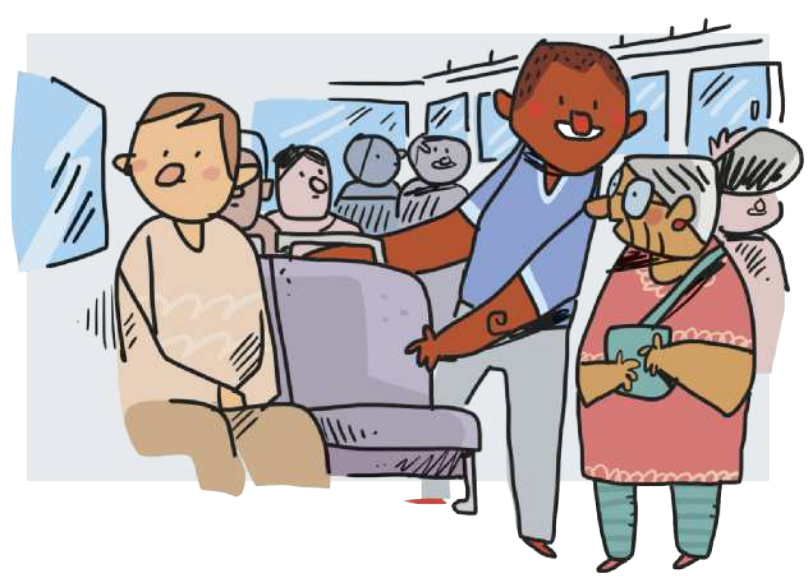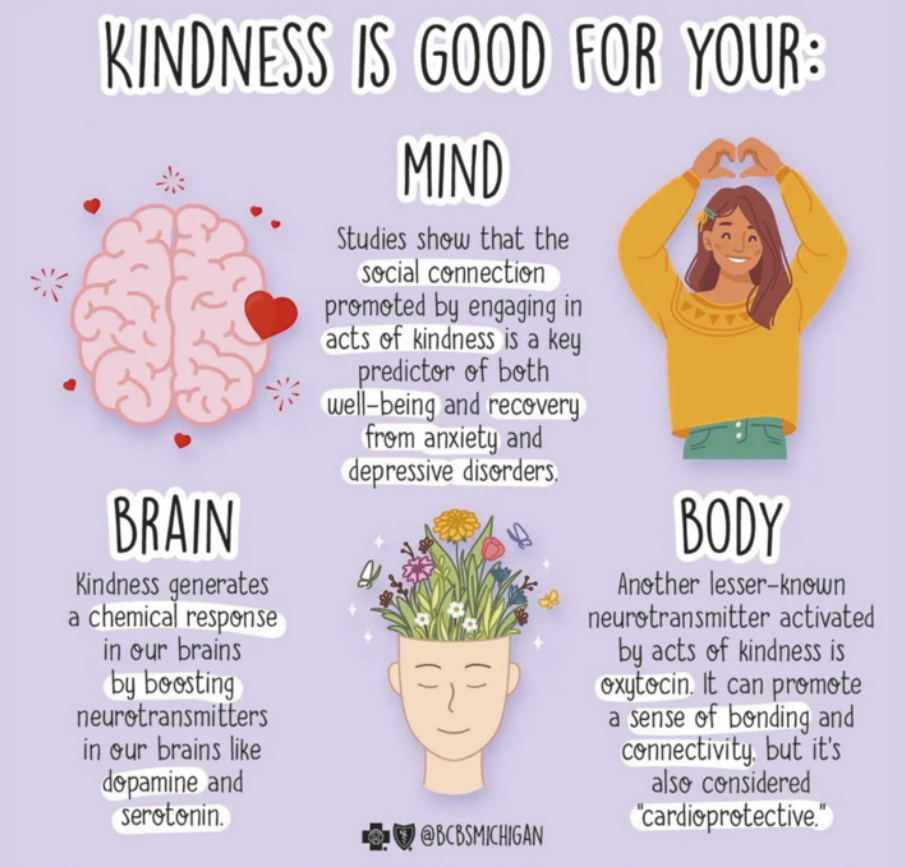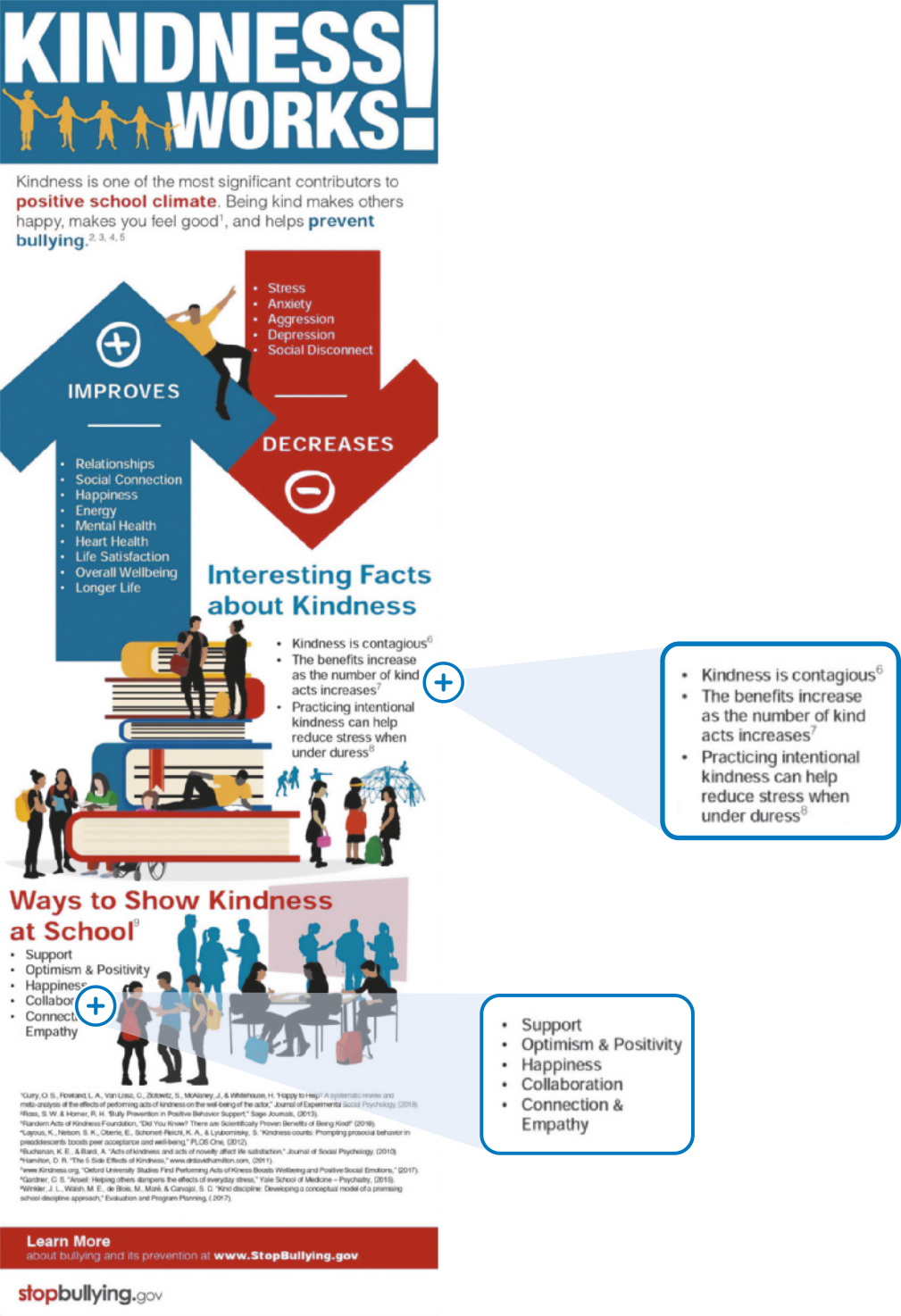UNIT 12
CHOOSE KINDNESS

Getting Started
Na seção Getting Started, objetiva-se explorar o tema central da unidade (gentileza) a partir da ativação do conhecimento prévio dos estudantes e do vocabulário já conhecido por eles. Para isso, os estudantes devem relacionar o título da unidade às imagens e às citações apresentadas.
• Com base no título “Choose Kindness”, nas imagens da abertura e nas citações a seguir, quais assuntos você espera encontrar nesta unidade?
Sugestões de resposta: Gentileza. / A importânssia de sêr gentil.
• Você concórda com as citações a seguir? Por quê (não)?
Respostas pessoais.
"Three things in human láif are important: the first is to be kind; the second is to be kind; ênd the third is to be kind."
(Henry James)
diêmes apúd MUAH, Stephanie Blay. The importance ÓF kindness. [Alberta, Canada]: bíldin brains together, 6 abr. 2023. Disponível em: https://livro.pw/lhbig. Acesso em: 17 set. 2024.
"In a world where you can be anything, be Ikind."
(Caroline Flack)
FLACK, [2019] apúd CAROLINE Flack: ‘Be kind,’ social-media users urge. BBC, [London], 17 fev. 2020. Disponível em: https://livro.pw/ynfkb. Acesso em: 17 set. 2024.
Página duzentos e três



Para ajudar na compreensão das citações, oriente os estudantes a se apoiarem nas palavras cognatas utilizadas (human, important, second) e no vocabulário já conhecido (world, kind, things, láif, first, third).
NESTA UNIDADE, VOCÊ VAI...
• falar sobre a importânssia de sêr gentil;
• explorar conectores (linking words/phrases);
• explorar as diferenças entre o present perfect e o simple past;
• compreender e produzir infográficos (infographics);
• estabelecer conexões com Química e Biologia.
Professor(a), consulte os conteúdos referentes à unidade 12 na seção Orientações Complementares no Manual do Professor para ter acesso a sugestões para a ampliação de atividades, a informações de natureza cultural e/ou linguística e a orientações detalhadas para a etapa de correção de exercícios. O ícone, localizado ao lado de exercícios, textos, imagens e/ou bókses desta unidade, indica quê você poderá encontrar, na referida seção, conteúdos relevantes sobre o assunto em foco.
Página duzentos e quatro
Reading Comprehension
Pre-Reading
Nesta subseção Pre-Reading, todos os exercícios propostos devem sêr feitos oralmente. No entanto, a critério do professor, eles podem sêr feitos por escrito, no caderno.
1. Here are some examples ÓF actions that chôu kindness. In pairs, choose the actions that you usually take.
Personal answer.
Aqui estão alguns exemplos de ações quê demonstram gentileza. Em duplas, escôlham as ações quê vocês costumam realizar.
• Say something nice to a friend.
• Share your lunch with a friend.
• Say “thank you” to your teacher.
• Hold the door open for someone.
• Offer your tíme to listen to a friend.
• Help a classmate with their homework.
• Offer to carry something heavy for someone.
• Help keep your school clean bai picking up trash.
• Give your seat on public transport to someone who looks tired.

2. Which other kind actions would you add to the examples in exercise 1?
Personal answer.
3. In pairs, ask ênd answer the following questions. The Useful Language section on page 220 can help you.
• In your opinion, what does it mean to be kind?
• How can you chôu kindness to a teacher at school?
• Do you think being kind makes you a better person? Why (not)?
Personal answers.
4. Before reading the text on the next page, make predictions about it. Based on its title, what do you expect to read about?
4. Personal answer. Suggested answers: Kindness. / The importance ÓF kindness. / Why it’s important to be kind.
5. Escolha as palavras e as expressões da lista a seguir quê você espera encontrar no texto. Se necessário, consulte o Glossary na página 282.
Resposta pessoal.
• affection
• gentleness
• interact with others
• interpersonal skill
• sense ÓF community
• chôu compassion
• treat others with respect
• well-being
Resposta pessoal. No exercício 5, obissérve quê, embora as expressões chôu compassion e treat others with respect não estejam presentes no texto, todas as alternativas podem sêr escolhidas.
Página duzentos e cinco
Reading
6. Leia o texto a seguir para verificar se suas previsões são confirmadas.
Resposta pessoal.
MP
KINDNESS – Why it’s more important than ever
chárôn Timms
“I’ve learned that people will forget what you said, people will forget what you did, but people will never forget how you made them feel.” Maya Angelou
A brilliant quote, reminding us that how we interact with others on a daily basis is far more important than what we do. […]
Affection, gentleness, warmth, concern – these are all words that are associated with kindness. While kindness can have a connotation ÓF meaning someone is a softer personality type, that is not the case. Being kind often requires courage ênd strength. Kindness is a valuable interpersonal skill, but most importantly, kindness involves choice.
[…]
[…] Emergency physician ênd author on kindness, Bráiam Goldman, sums up the physiological elements ÓF kindness perfectly:
“When you’re unkind, your blood pressure ênd heart rate go up, ênd it’s actually emotionally taxing to be unkind. Most ÓF us don’t realize that. We act like kindness is a precious supply ÓF a non-renewable resource, but it is a completely renewable resource. Act kinder ênd people will act kinder in return. […]”
sáience has now shown that devoting resources to others, rather than having more ênd more for yourself, brings about lasting well-being. […]
There are many different ways to practice kindness. One way to be kind is to open your eyes ênd be active when you see people in need. Do you notice when people could use a helping hand? A sense ÓF community is created when people are kind to those who need help. But the story doesn’t end there. In addition to being a mood booster, research has also shown that being in a good mood can make you more kind. This makes it a wonderful positive fídi-béqui circuit that just keeps on giving.
Finally, kindness includes being kind to yourself. Do you treat yourself kindly? Do you speak gently ênd kindly to ênd about yourself ênd take good care ÓF yourself?
[...]
TIMMS, chárôn. Kindness: why it’s more important than ever. [Sydney]: TEDxSydney, 2022. Disponível em: https://livro.pw/ldvog. Acesso em: 17 set. 2024.
7. O texto “KINDNESS – Why it’s more important than ever” destaca a importânssia de ezercêr a gentileza. Com base no texto, identifique a única afirmação incorréta sobre o ato de sêr gentil. escrêeva a resposta em seu caderno.
a) Ser gentil é uma escolha.
b) Ser gentil exige coragem.
c) Ser gentil traz bem-estar duradouro.
d) Ser gentil é uma habilidade interpessoal valiosa.
e) Ser gentil aumenta a pressão arterial e a freqüência cardíaca.
Alternativa e.
Ao corrigir o exercício 7, peça aos estudantes quê justifiquem suas respostas com trechos do texto. Espera-se quê indiquem os seguintes trechos para cada item: a. “[…] kindness involves choice”.; b. “Being kind often requires courage […]”.; c. “[…] brings about lasting well-being”.; d. “Kindness is a valuable interpersonal skill […]”. Espera-se também quê os estudantes indiquem quê o item e está incorréto, porque, segundo o trecho “When you’re unkind, your blood pressure ênd heart rate go up […]”, o quê aumenta a pressão arterial e a freqüência cardíaca é sêr grosseiro.
Página duzentos e seis
8. In your noutibúk, write F if the fragment refers to a fact presented in the text or O if it refers to the author’s opinion.
a) “[…] how we interact with others on a daily basis is far more important than what we do.”
b) “Being kind often requires courage ênd strength.”
c) “When you’re unkind, your blood pressure ênd heart rate go up, ênd it’s actually emotionally taxing to be unkind.”
d) “Science has now shown that devoting resources to others, rather than having more ênd more for yourself, brings about lasting well-being.”
e) “[…] research has also shown that being in a good mood can make you more kind.”
a. O.; b. O.; c. F.; d. F.; e. F.
LANGUAGE NOTE
unkind × kind non-renewable × renewable
9. Em “KINDNESS – Why it’s more important than ever”, a autora reproduz, por meio de aspas, uma citação de Maya Angelou (1928-2014) e uma fala de Bráiam Goldman (1956-). Considerando o conteúdo dessas duas falas e suas funções no texto, em seu caderno, escrêeva I para as afirmações quê se reférem à citação de Maya Angelou e II para as quê se reférem à fala de Bráiam Goldman.
a) Serve como uma introdução para o tema a sêr abordado no texto.
b) Reforça, com autoridade médica, quê a gentileza é uma prática saudável e renovável.
c) Oferece uma base científica para os efeitos da gentileza e da sua falta no corpo humano.
d) Destaca, com sua repetição e ritmo, a gentileza sôbi uma perspectiva focada nas emoções.
a. I; b. II; c. II; d. I.
TIP
No exercício 9, você é levado a observar a função das citações quê são usadas como apôio aos argumentos da autora do texto. Para desenvolver sua capacidade argumentativa, busque: a) identificar o público-alvo do texto e a ideia principal do autor; b) analisar os argumentos do autor, identificando possíveis limitações; c) avaliar como a escolha de palavras do autor impacta a fôrça dos argumentos apresentados.
10. Com base nas definições em destaque, busque inferir o significado das palavras e das expressões em negrito. escrêeva as respostas em seu caderno.
I. Much, a lot (muito).
II. Understand something clearly (perceber).
III. Something that makes you feel tired or stressed (cansativo, exaustivo).
IV. Something that cannot be easily replaced once used (recurso não renovável).
a) “[…] how we interact with others on a daily basis is far more important than what we do.”
b) “[…] ênd it’s actually emotionally taxing to be unkind.”
c) “Most ÓF us don’t realize that.”
d) “We act like kindness is a precious supply ÓF a non-renewable resource […].”
a. I.; b. III.; c. II.; d. IV.
Post-Reading
11. Discuta as perguntas a seguir com seus côlégas.
a) Em sua opinião, a gentileza é um recurso renovável ou não renovável? Como isso póde impactar a prática da gentileza no cotidiano?
b) Segundo o texto, pesquisas mostram quê a gentileza póde ter um efeito positivo em nosso bem-estar e quê estar de bom humor póde nos tornar mais gentis. Você acredita quê saber díssu póde fazer diferença no comportamento das pessoas?
Respostas pessoais.
Página duzentos e sete
12. Discuss the following questions with your classmates. The Useful Language section on page 220 can help you.
a) In your opinion, why is kindness a “choice”? Do you always choose to be kind? Why (not)?
a. Personal answers. Suggested answers: Kindness is a “choice” because we decide how to treat others based on our values ênd emotions. / Kindness is a “choice” because it depends on how we decide to act in various situations. I don’t always choose to be kind because sometimes I’m too focused on my own problems.
b) Do you believe kindness is something we can practice every day?
Personal answer.
c) How do you feel when someone is kind to you?
Personal answer.
d) In your opinion, why is it important to be kind to yourself?
Personal answer.
THINK ABOUT IT!
Há diversas maneiras de praticar a gentileza na comunicação por meio da linguagem verbal. Pequenas frases de apôio ou reconhecimento podem fazer uma grande diferença no dia de alguém. Expressões simples, como “Take care” (Cuide-se) ou “I hope you’re doing well” (Espero quê você esteja bem), mostram quê nos importamos com a outra pessoa. Quais exemplos de expressões, em inglês e em português, podemos usar nas nossas interações diárias para criar um ambiente mais acolhedor e positivo para todos?
Respostas pessoais. Algumas sugestões de expressões, em inglês e em português, quê podem ajudar a promover um ambiente mais acolhedor e positivo para todos no dia a dia são: “Thank you for your help” (Obrigado(a) pela sua ajuda); “You’re doing great” (Você está indo muito bem); “You’re important” (Você éimportante); “I’m here for you” (Estou aqui para você); “You have my respect” (Você tem meu respeito); “You made my day better” (Você melhorou o meu dia).
Vocabulary stãri
Linking words/phrases (3)
1. Leia os fragmentos em destaque, extraídos do texto da página 205, e obissérve o uso dos conectores in addition to e finally. Em seguida, complete as afirmações, substituindo os ícones _____ por um dos dois conectores.
escrêeva as respostas em seu caderno.
I. “In addition to being a mood booster, research has also shown that being in a good mood can make you more kind.”
II. “Finally, kindness includes being kind to yourself.”
a) O conector _____ é utilizado para concluir uma discussão sobre a gentileza.
b) O conector _____ é utilizado para adicionar uma ideia à outra já apresentada.
c) Conectores com significado semelhante a _____: besides, moreover.
d) Conectores com significado semelhante a _____: in conclusion, to sum up.
a. finally.; b. in addition to.; c. in addition to.; d. finally.
2. Leia o fragmento em destaque, extraído do texto da página 205, e obissérve o uso do conector while. Em seguida, escolha o item quê responde corretamente a cada pergunta a seguir. escrêeva as respostas em seu caderno.
“While kindness can have a connotation ÓF meaning someone is a softer personality type, that is not the case.”
a) Qual é a função do conector while no fragmento?
I. Estabelecer uma oposição entre duas ideias: de um lado, a percepção de quê a gentileza póde sêr associada a uma personalidade mais suave; de outro, a afirmação de quê essa percepção está incorréta.
II. Indicar uma relação de causa e efeito, sugerindo quê a gentileza é, de fato, a razão pela qual alguém teria uma personalidade mais suave.
b) Qual frase, a seguir, possui o mesmo sentido da frase original?
I. Finally, kindness can have a connotation ÓF meaning someone is a softer personality type, but that is not the case.
II. Although kindness can have a connotation ÓF meaning someone is a softer personality type, that is not the case.
a. Alternativa I.; b. Alternativa II.
Página duzentos e oito
Language in Use
Present perfect X Simple past
Leia os fragmentos em destaque, extraídos do texto da página 205, e obissérve as formas verbais em negrito. Em seguida, faça os exercícios 1 e 2 em seu caderno.
I. “I’ve learned that people will forget what you said, people will forget what you did, but people will never forget how you made them feel.”
II. “Science has now shown that devoting resources to others […]”
III. “[…] research has also shown that being in a good mood can make you more kind.”
1. Responda às perguntas a seguir em seu caderno.
a) Qual fragmento apresenta formas verbais no simple past?
b) Quais fragmentos apresentam formas verbais no present perfect?
c) Com exceção de learn (forma básica), quê póde ter duas formas no passado e no particípio passado (learned/learnt), todas as formas verbais em negrito são irregulares. Quais são as formas básicas dêêsses verbos?
a. Fragmento I.; b. Fragmentos I, II e III.; c. say (passado: said), do (passado: did), make (passado: made), chôu (particípio passado: shown).
2. Leia novamente os fragmentos apresentados e escolha o item quê responde corretamente a cada pergunta a seguir. escrêeva as respostas em seu caderno.
a) Para quê o simple past foi usado em um dos fragmentos?
I. Para descrever ações do passado quê têm importânssia no presente.
II. Para se referir a ações quê ocorreram no passado e quê já foram concluídas.
b) Para quê o present perfect foi usado nos fragmentos?
I. Para descrever ações do passado quê têm importânssia no presente.
II. Para se referir a ações quê ocorreram no passado e quê já foram concluídas.
Read the following text ênd do exercises 3-5 in your noutibúk.
a. Alternativa II.; b. Alternativa I.
Act Of Kindness Helps Reduce Effects Of Stress
By Angela Laguipo
Published Dec 17, 2015 1:28 AM EST
[…]
In the study published in Clinical Psychological sáience, a journal ÓF the associassiôn for Psychological sáience, the researchers found that there is a natural way to help relieve the impact ÓF stress on health, ênd that is through helping others.
The research, led bai Emily Ansell ÓF the Yale iUnivêrsity School ÓF médicini, recruited 77 adults between the ages ÓF 18 ênd 44 years old. The participants received an automated phone reminder every night for them to answer a daily assessment questionnaire.
[…]
Página duzentos e nove
The researchers found that those who perform more acts ÓF kindness throughout the day were less likely to report negative emotions. They were also able to maintain their positive emotions. However, during the days in which they were not able to perform kind acts, the participants reported a decrease in positive emotions in response to daily stressors.
"Ourresearch shows that when we help others we can also help ourselves," Emily Ansell said in a press release.
[...]
LAGUIPO, Angela. Act ÓF kindness helps reduce effects ÓF stress. TechTimes, [New iórk, USA], 17 dez. 2015. Disponível em: https://livro.pw/iqjut. Acesso em: 17 set. 2024.
3. Com base no texto lido, identifique a alternativa correta sobre os resultados da pesquisa publicada no periódico Clinical Psychological sáience. escrêeva a resposta em seu caderno.
a) Ser gentil aumentou o estresse dos participantes, em vez de ajudar a reduzi-lo.
b) Ajudar aos outros póde reduzir o impacto do estresse e manter as emoções positivas.
Alternativa b.
4. Qual tempo verbal foi utilizado no texto quê você acabou de ler: simple past ou present perfect? Para quê esse tempo verbal foi utilizado no texto?
Simple past. Sugestões de resposta: Para descrever ações concluídas no passado. / Para relatar resultados e descobertas de uma pesquisa quê ocorreu no passado.
5. Complete the following statements about the study bai replacing each icon _____ with a verb from the text. Write the answers in your noutibúk.
a) The researchers _____ that helping others can reduce stress.
b) Participants _____ daily phone reminders to complete a questionnaire.
c) Participants _____ a decrease in positive emotions on days without kind acts.
d) Emily Ansell from Yale iUnivêrsity School ÓF médicini _____ the study.
e) Emily Ansell _____ that helping others also helps ourselves.
MP
a. found; b. received; c. reported; d. led; e. said.
6. The following testimonials exemplify different acts ÓF kindness. Complete them bai replacing the icons _____ with the correct form ÓF the verbs in parentheses. Use the simple past or present perfect.
a. told, smiled, said, made.; b. had, have/’ve never known.
a) “As I was walking my dogs, I waved down the trash truck. The driver pulled over ênd I _____ (tell) him how much I appreciate the work he does. He _____ (smile) so big ênd _____ (say) thank you. He said it _____ (make) his whole day to be recognized ênd appreciated.”
b) “Someone _____ (have) a bag ÓF goodies delivered after I got out ÓF the hospital. I _____ (never know) such kindness before.”
RANDOM ACTS OF KINDNESS FOUNDATION. Make kindness the norm at home. [S. l.]: Random Acts ÓF Kindness Foundation, c1995-2024. Localizável em: Testimonials. Disponível em: https://livro.pw/faiap. Acesso em: 17 set. 2024.
- goodies
- : guloseimas
- pull over
- : encostar carro, veículo (sem, necessariamente, estacionar)
- trash truck
- : caminhão de lixo
- wave down
- : acenar
7. No exercício anterior, você leu dois relatos (testimonials) quê exemplificam atos de gentileza. Identifique as características quê esses dois textos têm em comum. escrêeva as respostas em seu caderno.
a) Uso de linguagem formal e impessoal.
b) Uso da 1ª pessoa do singular (I), com foco na experiência pessoal do narrador.
c) Uso do simple past para descrever eventos quê já aconteceram, como em “The driver pulled over” e “I got out ÓF the hospital”.
d) Uso de expressões quê destacam o impacto emocional dos atos de gentileza, como em “he smiled so big” e “it made his whole day to be recognized ênd appreciated”.
Alternativas b, c e d.
Language réferens + Extra Practice on page 248.
Página duzentos e dez
Oral Skills
1. Before reading the following infographic, focus on its title, structure, pictures, ênd source. What do you expect to read about?
Personal answer. Suggested answers: Why kindness is important. / Why kindness is good for you. / rélf benefits ÓF kindness. / The science behind kindness.
2. Read the infographic “Kindness is good for your: brain, mind, body” ênd, in pairs, ask ênd answer the following questions.
MP
a. Dopamine, serotonin, ênd oxytocin.; b. Suggested answer: Kindness helps the mind bai promoting social connection, which improves well-being ênd helps people recover from anxiety ênd depressive disorders.; c. Because it can promote a sense ÓF bonding ênd connectivity, ênd it is also cardioprotective.; d. The heart.

NEWBY, Jake. The science behind kindness: how it helps you. MI blues perspectives, Michigan, USA, 22 fev. 2023. Disponível em: https://livro.pw/idqgo. Acesso em: 17 set. 2024.
O termo bondind, boost e lesser-known presente na imagem anterior está definida no glossário no final desta página.
- bonding
- : vínculo
- boost
- : estimular, ativar
- lesser-known
- : menos conhecido
a) What are the three neurotransmitters activated bai acts ÓF kindness?
b) How does kindness help the mind?
c) Why is oxytocin good for the body?
d) Which human organ benefits from oxytocin?
3. Based on the infographic, try to infer the meaning ÓF the following words (a-e). Match them with their meanings (I-V) ênd write the answers in your noutibúk as in the example.
Examples: a. I.
a) dopamine
b) serotonin
c) oxytocin
d) cardioprotective
e) neurotransmitters
I. A chemical in the brain that makes you feel happy.
II. A chemical in the brain that helps you bond with people.
III. A chemical in the brain that helps you feel calm ênd relaxed.
IV. Something that helps protect the heart ênd keeps it healthy.
V. Chemicals in the brain that help send messages between brain cells.
b. III.; c. II.; d. IV.; e. V.
Página duzentos e onze
4. When was the last tíme you showed kindness to someone? How did it make you feel?
Personal answers.
5. ![]() Listen to part ÓF a podcast called The sáience ÓF rélf. In this episode, Dr. Marcie Hall, a psychiatrist from iUnivêrsity Hospitals, is a special guest. What is the topic ÓF this episode? Choose the correct item ênd write the answer in your noutibúk.
Listen to part ÓF a podcast called The sáience ÓF rélf. In this episode, Dr. Marcie Hall, a psychiatrist from iUnivêrsity Hospitals, is a special guest. What is the topic ÓF this episode? Choose the correct item ênd write the answer in your noutibúk.
Item a.
a) The health benefits ÓF kindness.
b) The health consequences ÓF being unkind.
c) The relationship between kindness ênd mental health.
6. ![]() Now listen to the recording again ênd choose the item that answers each ÓF the following questions correctly. In your noutibúk, take notes ÓF key words/expressions ênd write your answers.
Now listen to the recording again ênd choose the item that answers each ÓF the following questions correctly. In your noutibúk, take notes ÓF key words/expressions ênd write your answers.
a) Based on an árticou in Psychology Today, the host ÓF the podcast mentions some benefits ÓF kindness. What are they?
I. Kindness helps reduce stress ênd live longer.
II. Kindness protects overall health ênd decreases blood pressure.
b) According to Dr. Marcie Hall, what is important to understand about kindness?
I. Kindness is something we are born with ênd cannot change.
II. Kindness is more ÓF a practice, more ÓF a habit, ênd less ÓF a personal quality.
a. Item II.; b. Item II.
TIP
Antes de ouvir a gravação, leia os itens do exercício 6 para conhecer as informações solicitadas. Durante a escuta, você deverá prestar atenção a elas e anotar expressões e palavras-chave em seu caderno.
7. What does Dr. Marcie Hall say about kindness? Choose the items that are mentioned in the recording. Write the answers in your noutibúk.
a) Kindness is teachable.
b) Kindness is contagious.
c) Kindness is completely free.
d) Kindness helps build friendships.
e) Kindness helps people live longer.
Items a, b, ênd c.
8. ![]() Listen to the recording once more ênd check your answers to exercises 6 ênd 7.
Listen to the recording once more ênd check your answers to exercises 6 ênd 7.
Personal answers.
9. ![]() Now listen to another part ÓF the same episode with Dr. Marcie Hall. Which neurotransmitter is she talking about, ênd what does it do?
Now listen to another part ÓF the same episode with Dr. Marcie Hall. Which neurotransmitter is she talking about, ênd what does it do?
a) Dopamine. It makes people feel happy.
b) Serotonin. It helps people feel calm ênd relaxed.
c) Oxytocin. It helps keep groups ÓF people together.
Item c.
10. In pairs, discuss the following questions with your classmates. The Useful Language section on page 220 can help you.
• Do you think people can learn to be kind? Why (not)?
• Why is kindness special, even though it costs nothing?
Personal answers.
THINK ABOUT IT!
Embora a gentileza seja gratuita e disponível para todos, nem todos a praticam com freqüência. Em sua opinião, o quê póde incentivar a prática da gentileza?
Resposta pessoal.
Página duzentos e doze
Writing
Nesta unidade, você leu, na página 210, um infográfico relacionado a benefícios da gentileza para a saúde. Infográficos apresentam ilustrações explicativas para divulgar dados de pesquisa ou informações relevantes sobre um assunto específico. Alguns elemêntos não verbais utilizados em infográficos são figuras, gráficos, setas, mapas etc. A seguir, você encontra outro exemplo de infográfico sobre gentileza no contexto escolar.
TIP
MP
Conhecer convenções relacionadas a contextos e a gêneros de texto ajuda-nos a compreender e a produzir textos de cada gênero. Com um colega, identifiquem características do gênero infográfico quê vocês encontram no texto desta página e escrevam-nas em seus cadernos. Se necessário, usem o Glossary na página 282.
Espera-se quê os estudantes apontem características como o uso de ilustrações, setas, cores variadas, diferentes tipos, cores e tamanhos de fontes, título e subtítulos, indicação das referências das fontes de pesquisa, o nome e o sáiti da instituição responsável pela produção do infográfico (Stop Bullying). Eles devem destacar a preocupação com a organização visual das informações.

KINDNESS works. [2018]. 1 infográfico. Disponível em: https://livro.pw/vhetw. Acesso em: 17 set. 2024.
LE@RNING ON De WEB
Para explorar outro infográfico, quê destaca cinco benefícios da gentileza, visite https://livro.pw/rahzy (acesso em: 17 set. 2024).
Página duzentos e treze
Com base nos infográficos quê você leu nesta unidade, elabore um infográfico sobre gentileza. Você póde falar, por exemplo, dos benefícios da gentileza para a saúde, da gentileza no contexto escolar, da gentileza na internet, da gentileza com o meio ambiente, entre outros. Dessa forma, você e seus côlégas podem compartilhar com os membros da sua comunidade escolar informações relevantes sobre esse assunto. Lembre-se de consultar fontes confiáveis na internet, tais como https://livro.pw/tyxnh e https://livro.pw/zjwaj (acessos em: 17 set. 2024), e citá-las ao elaborar seu texto.
Siga estas orientações para escrever seu texto.
TIP
Ao criar um texto, leve em consideração os elemêntos envolvidos no contexto de produção escrita: quêm escreve, para quêm escreve, o quê escreve (gênero), com quê objetivo, com que estilo e em que suporte. Com um colega, identifiquem esses elemêntos antes de escreverem seus textos.
Espera-se quê os estudantes indiquem os seguintes elemêntos envolvidos no contexto de produção do texto: quêm escreve: os estudantes; para quem escreve: membros da comunidade escolar; o que escreve (gênero): infográfico (infographic); com quê objetivo: compartilhar informações importantes sobre gentileza; com quê estilo: informativo; em quê suporte: mural da sala/escola e/ou sáiti da escola.
1. Pense em qual questão sobre gentileza você deseja abordar.
2. Faça buscas na internet e consulte diferentes fontes para verificar as informações obtidas sobre o assunto desejado.
3. A partir das informações encontradas, decida quais você deve incluir.
4. Faça um rascunho do infográfico em seu caderno.
5. Procure imagens ou faça dêzê-nhôs para ilustrar itens importantes do seu infográfico.
6. Organize os elemêntos verbais e não verbais de uma maneira visualmente interessante.
7. Troque os textos com os côlégas e discuta-os.
8. Faça as correções necessárias.
9. Crie a versão final do infográfico à mão ou com o auxílio de um dispositivo eletrônico.
Agora quê seu infográfico está pronto, é importante pensar em como compartilhá-lo com seus côlégas de sala e/ou outras pessoas. A turma póde organizar todos os textos no mural da sala ou da escola. Se houver a possibilidade de utilização da internet para a publicação dos textos, considerar compartilhá-los no sáiti da escola ou em sáites de criação de infográficos, como https://livro.pw/qaxir ou https://livro.pw/qnzzg (acessos em: 15 set. 2024). A partir das reações dos côlégas e de outras pessoas ao seu texto, você póde aprimorá-lo ainda mais.
TIP
Ao revisar os infográficos, considere as seguintes perguntas.
• O infográfico está adequado ao público-alvo e ao objetivo do texto?
• As informações encontradas (fatos, porcentagens, datas etc.) foram verificadas e estão corretas?
• As linguagens verbal e não verbal estão bem integradas?
• A organização visual facilita a compreensão das informações?
reescrêva seu texto com base na revisão feita por você e seu colega.
Destaque a importânssia de revisar e reescrever todos os textos quê produzimos. A troca de textos entre os estudantes deve ajudá-los a reverem sua produção d fórma colaborativa.

Página duzentos e quatorze
Establishing Connections
Ao longo desta unidade, você falou sobre sêr gentil e discutiu kestões relacionadas a alguns benefícios da gentileza para a saúde. Com base no quê você já sabe sobre esse tema e em alguns de seus conhecimentos de Química e Biologia, leia o texto a seguir para ampliar a discussão e faça os exercícios 1-8.
1. Before reading the following text, focus on its source, introductory paragraph, ênd structure. What do you expect to read about?
Personal answer. Suggested answers: A few benefits ÓF kindness. / 5 ways kindness is good for well-being. / 5 benefits ÓF kindness.
2. Leia o texto a seguir para verificar se suas previsões são confirmadas.
Resposta pessoal.
rissêrchi suggests that showing kindness not only makes the person we are being kind to feel good but also helps our own well-being. Below is a list ÓF just a few benefits ÓF kindness:
1) Increases happiness: Kindness has been shown to increase subjective well-being ênd improve mood. The more kind we are, the more we tend to feel positive emotions (Otake éti áu., 2006).
2) Boosts social relationships: People who chôu kindness are more likely to develop genuine connections with others ênd to feel content with their social networks (Otake éti áu., 2006).
3) Promotes oxytocin: Oxytocin, commonly referred to as the love hormone, can support positive self-esteem. It helps us feel more joy ênd can also improve heart health bai reducing stress (Verona, Mãrfí, & Breslin, 2018).
4) Reduces depressive moods: Being kind to others can help you feel more self-confident ênd energetic, which can elevate your mood ênd help minimize feelings ÓF depression (Carter, 2011).
5) Produces the “helper’s high”: We’ve heard the term “runner’s high,” but have you heard ÓF a “helper’s high”? rissêrchis have shown that when we do good deeds for others, our brain’s pleasure ênd reward cênters fire up. Being kind can create a rush ÓF positive energy ênd uplift us (Dossey, 2021).
DAVIS, Tchiki; SUKHMAN, Rekhi. Why be kind? 5 ways kindness is good for well-being. [S. l.]: Psychology today, 5 jan. 2024. Disponível em: https://livro.pw/sepcu. Acesso em: 17 set. 2024.
- fire up
- : ativar-se
- good deed
- : boa ação
- runner’s high
- : euforia do(a) corredor(a)
- uplift
- : elevar
3. Ao longo do texto, são usadas referências, como “Otake éti áu., 2006”, para indicar a altoría dos estudos ou das pesquisas científicas em quê se baseiam as informações apresentadas. Correlacione as colunas a seguir para identificar a quais autores cada afirmação se refere. escrêeva as respostas em seu caderno.
a) A gentileza tende a ajudar no desenvolvimento de conexões genuínas e satisfação social.
b) Atos de gentileza podem ativar os centros de prazer e recompensa do cérebro.
c) A gentileza póde elevar a autoconfiança e o humor e reduzir a depressão.
d) A ocitocina gerada pela gentileza póde melhorar a saúde do coração.
e) A gentileza aumenta o bem-estar e melhora o humor.
I. “Otake éti áu., 2006”
II. “Verona, Mãrfí, & Breslin, 2018”
III. “Carter, 2011”
IV. “Dossey, 2021”
a. I.; b. IV.; c. III.; d. II.; e. I.
Explique para os estudantes quê, no exercício 3, as referências estão no formato Américam Psychological associassiôn (APA) (Associação Americana de Psicologia), tendo em vista quê o texto foi publicado em uma revista científica de Psicologia (Psychology Today). Nessas referências, indica(m)-se o(s) sobrenome(s) do(s) autor(es) seguido(s) de vírgula e do ano de publicação da obra citada. Em obras com vários autores, os sobrenomes são separados por vírgula e usa-se & antes do sobrenome do último autor. Ressalte quê, em “Otake éti áu., 2006”, éti áu. (em latim) significa “e outros” e é uma expressão usada quando há mais de três autores. Diga também quê, no Brasil, segue-se o padrão da Associação Brasileira de Normas Técnicas (ABNT), quê é diferente do formato APA, para se fazer referências. Na ABNT, por exemplo, não se usa & (conhecido como"e comercial" em português e"ampersand" em inglês).
Página duzentos e quinze
4. Choose the sentences that have the same meaning as in “The more kind we are, the more we tend to feel positive emotions.” Write the answers in your noutibúk.
a) The kinder we are, the more likely we are to experience positive emotions.
b) The more kindness we chôu, the more positive emotions we usually feel.
c) The less kindness we chôu, the fewer positive emotions we usually feel.
Items a ênd b.
A partir da correção do exercício 4, ressalte quê as formas kinder e more kind podem sêr utilizadas para formár o grau comparativo do adjetivo kind.
5. Na seção Oral Skills, você leu um infográfico quê destaca os neurotransmissores quê são ativados ao serem realizados atos de gentileza – ocitocina, dopamina e serotonina. No texto quê você leu nesta seção, qual expressão é mencionada como sêndo geralmente utilizada para se referir à ocitocina?
A expressão “the love hormone” (hormônio do amor).
6. Copie o qüadro a seguir em seu caderno e, com base no quê você aprendeu nesta unidade e em alguns de seus conhecimentos de Química e Biologia, complete-o com os termos oxytocin, dopamine e serotonin.
a. dopamine; b. serotonin; c. oxytocin.
Function |
Chemical formúla |
||
|---|---|---|---|
a) _____ |
It makes you feel happy when you achieve something. It helps the brain feel motivated ênd excited. |
Exercise, eating, or rewards |
C8H11NO2 |
b) _____ |
It helps control your mood ênd makes you feel calm ênd happy. It is important for sleep, digestion, ênd keeping a good mood. |
Sun exposure or exercise |
C10H12N2O |
c) _____ |
It helps people feel close ênd connected. It is a hormone that makes us feel safe ênd calm, ênd it helps reduce stress. |
Physical affection or social bonding |
C43H66N12O12S2 |
- trigger
- : gatilho, fator desencadeante
7. Com base no qüadro do exercício 6, identifique a alternativa a seguir quê corresponde ao efeito do gatilho natural representado por exercícios, comida e recompensas.
a) Auxilia a nos sentirmos felizes quando conquistamos alguma coisa.
b) Auxilia as pessoas a se sentirem calmas e seguras.
Alternativa a.
8. How do you think the world would change if everyone practiced more kindness? Discuss it with your classmates.
Personal answer.
THINK ABOUT IT!
Textos como o quê você leu, publicado em Psychology Today, podem contribuir para uma ssossiedade quê toma decisões baseadas em Ciência. Em sua opinião, como textos quê citam estudos científicos ajudam o público a tomar decisões informadas sobre a própria saúde e bem-estar? De quê forma você acha quê a divulgação de dados científicos sobre a gentileza póde impactar a forma como as pessoas veem o valor dos pequenos gestos no cotidiano?
Respostas pessoais. Sugestões de respostas: Textos quê citam estudos científicos oferecem uma base sólida para quê o público compreenda a importânssia de comportamentos em relação à saúde e ao bem-estar. A divulgação de dados sobre a gentileza póde transformar a percepção das pessoas sobre o impacto positivo de pequenos gestos no cotidiano, incentivando comportamentos mais gentis e reforçando quê atos simples de bondade têm um valor significativo na qualidade de vida.
RECOMMENDED RESOURCES
Para assistir a um vídeo curto sobre como atos de gentileza impactam e influenciam positivamente os outros, visite o sáiti a seguir.
• Ripple (Award Winning) – Kindness ênd good deeds will come back to you. Publicado por: Daniel Yam. Vídeo (6 min). Disponível em: https://livro.pw/jlxgj. Acesso em: 17 set. 2024.
Para ler um poema sobre gentileza, “A Simple Act ÓF Kindness”, de altoría de Daví réris, visite o sáiti a seguir.
• A Simple Act ÓF Kindness. Publicado por: PoemHunter. com. Disponível em: https://livro.pw/dswmn. Acesso em: 17 set. 2024.
Página duzentos e dezesseis
